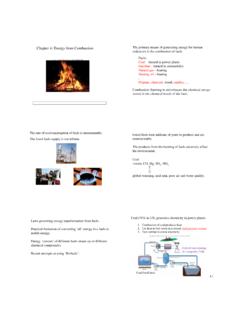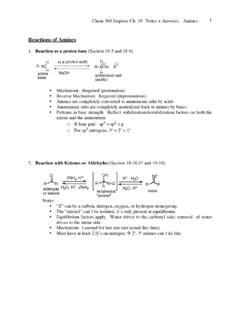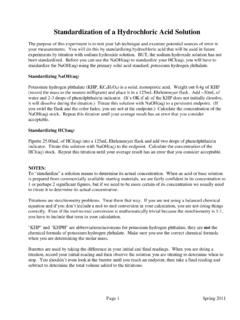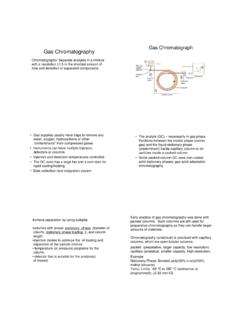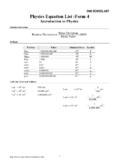Transcription of Mass Spectroscopy
1 1 mass SpectroscopyMass Spectroscopy is a technique causing the formation of the gaseous ions with or without fragmentation; the gas phase ions are then characterized by their mass to charge ratios (m/z) and their relative MS, compounds are ionized. The ionized molecule often fragments into smaller ions/radicals. The positively charged fragments produced are separated based on their nominal_mass/charge (m/z) ion daughter ions, radicals, neutralsMost of the ions has z=+1, thus in a given ion, m/z = mass of the plot of relative abundance of ions vs m/z of all charged particles is the mass fragmentationM M+.
2 M+1+ M+.2+..+N1+ N2. + .. If the quantity of energy supplied to a molecule is greater than it s ionization energy a molecular ion is formed (parent ion).The mass spectral pattern is unique to a molecule(fingerprint), especially massMolecularion M+.Molecularion M+.++Base peakv. stable ionDaughter ionsFree radicalsneutralsMass Spectrum presented as a bar Peak M+.: An molecular ion that has not lost/gained atoms. The nominal mass of which is calculated with the mass numbers of the predominant isotopes of peak:Base peak is the peak from the most abundant ion, which is often the most stable peaks other than the molecular ion peak is given the symbol A, then it s isotopic peaks would be A+1, A+2, ,,,Fragmentation: M1++ +.
3 + N2M+.M+M3++ NM+.Radical ion (odd e) radical (odd e)N Neutral (even e)M+(even e) would not break up into a radical Isotope peaksA peak made up of the principal isotopes of atoms making up the +1=( + + + + + )Cl-CH2-CH2-S-CH2-CH2-ClCl-*CH2-CH2-S-CH 2-CH2-ClCl-CH2-*CH2-S-CH2-CH2-Cl*Cl-CH2- CH2-S-CH2-CH2-Cl*Cl-*CH2-CH2-S-CH2-CH2-C l*Cl-CH2-CH2-S-CH2-CH2-* cannotdistinguish between isotopomers(isomers having the same number of each isotopic atom but differing in their positions). 3 mass Spectrometer:Create gas-phase ions of ions in space or time basis based on m/z ratio accomplished by mass the quantity of ions of each ion based on them/z ratio.
4 **Ionization:Electron Ionization (Electron Impact, EI) Chemical Ionization (CI)Field Desorption (FD) IonizationFast Atom Bombardment (FAB) Matrix Assisted Laser Desorption Ionization (MALDI)Thermospray IonizationElectrospray (ESI)Atmospheric Pressure Ionization (API) Atmospheric Pressure Chemical Ionization (APCI) Inductively Coupled Plasma (ICP) Electron impact ionization (EI)-+Ekin= zV = mv2/2 VIon optics70eV high energy electrons, molecular ion - very energetic, low/no compound is ionized by electron impact. An electron beam is generated by a accelerating theelectrons from a heated filament through an applied voltage.
5 The electron energy is defined by the potential difference between the filament and the source housing and is usually set to 70 eV (~ ). A field keeps the electron beam focused across the ion source and onto a trap (collimating magnets).Upon impact with a 70 eV electron, the gaseous molecule may lose one of its electrons to become a positively charged radical ion, daughter ions, ionization (CI):Interaction of the molecule M with a reactive ionized reagent species (gaseous Bronsted acids). , EI of methane, generates CH4+ which then reacts to give the Bronsted acid CH5+; CH4+ + CH4 CH5++ CH3 If M in the source has a higher proton affinity than CH4, the protonated species MH+will be formed by the exothermic + CH5+ MH++ CH4CI is a softer ionization +.
6 Nearly M+.Ion Detection: Faraday Cup Electron Multiplier Photomultiplier Conversion Dynode mass Analyzers: Magnetic Sector mass Analyzer(Single/Double Focusing )Quadrupole QuadrupoleIon Trap Fourier-Transform mass Spectrometry (FTMS) Time-of-flight (TOF)Tandem mass Spectrometry MS-MS(n)5MS/MSQqQ (triple quad)MS1MS2 Dissociation regionScan with MS1 (only) turned on entire MS MS1 to filter fragment of interest, dissociate furtherin q collisionally and mass analyze by scanning with SpectraEI spectra are rich in fragments thus useful in structure determination (thro interpretation).
7 Parent ion may be absent (aliphatic alcohols, nitrites, nitrates, nitro compounds nitriles and highly branched compounds).Intensity of peaks depends on the stability of the losses point to characteristic moieties in the molecule O(16), OH (17), H2O (18) losses from alcohols. (M-3 to M-14 and M-19 to M-25 peaks are unlikely, exceptions exist; HF(20) loss)Molecular Ion PeakThe highest mass ion in the spectrum. Provides the most valuable information; molecular mass of the molecule. That leads to elemental composition. Structural fragments are then fitted into the elemental composition.
8 (CI and FAB).M+.: MW (unit mass ) in terms of the most abundant isotope of each element present. It is an OE ion. It yields ions in the high mass range by loss of logical neutral Rule:Molecule of even nominal mass must contain zero or even number of N atoms. An odd numbered nominal mass requires an odd number of Rule (molecules and OE molecular ions, M+.)Nearly all molecules are even electron the nominal mass is even, the compound contain an even number of N atoms; 0,2,4,6,..If the nominal mass is odd, the compound contain an odd number of N atoms; 1,3,5,7.
9 Nitrogen Rule (EE molecular ions)EE precursor ions (M+H)+, (M+Na)+, (M+Cl)-etc; the N rule is; If the nominal mass is odd, the compound contain an even number of N atoms; 0,2,4,6,..If the nominal mass is even, the compound contain an odd number of N atoms; 1,3,5,7,..Parent Peak leads to molecular formula. (Appendix A)Molecular formula leads to the structural (/partial) featuresof the possible molecular be calculated from the molecular formula of M or fragments (octet rule) of the parent ion. 2/ 2/ 2 1#C #H & halogens; #N, P, divalent atoms (O,S)= + + = + +===U R DB TB c h nchnOE fragments generate integral U values, EE fragmentsgenerate U values which are odd multiples of of Thirteen:Used to generate possible formula for a given molecular Generate a base formula;MMrn1313= +CnHn+r2.
10 Calculate the index of U for the base r 2U2 +=3. If needed to find the formula with nOof O for the same MM;New formula = Base formula + nOO nOC 4nOHwhich changes U to U+nO;4. If needed to find the formula with nNof N for the same MM,New formula = Base formula + nNN nNC 2nNHand recalculate U; Fractional U s unlikely < 0 is an impossible combination, indicates likely presence of O and LinksMain PageMF Resolution MS:Using mass number for isotopes of atoms is approximate. Actual mass of a given isotope deviates this integer by a small but unique amount ( E = mc2).
